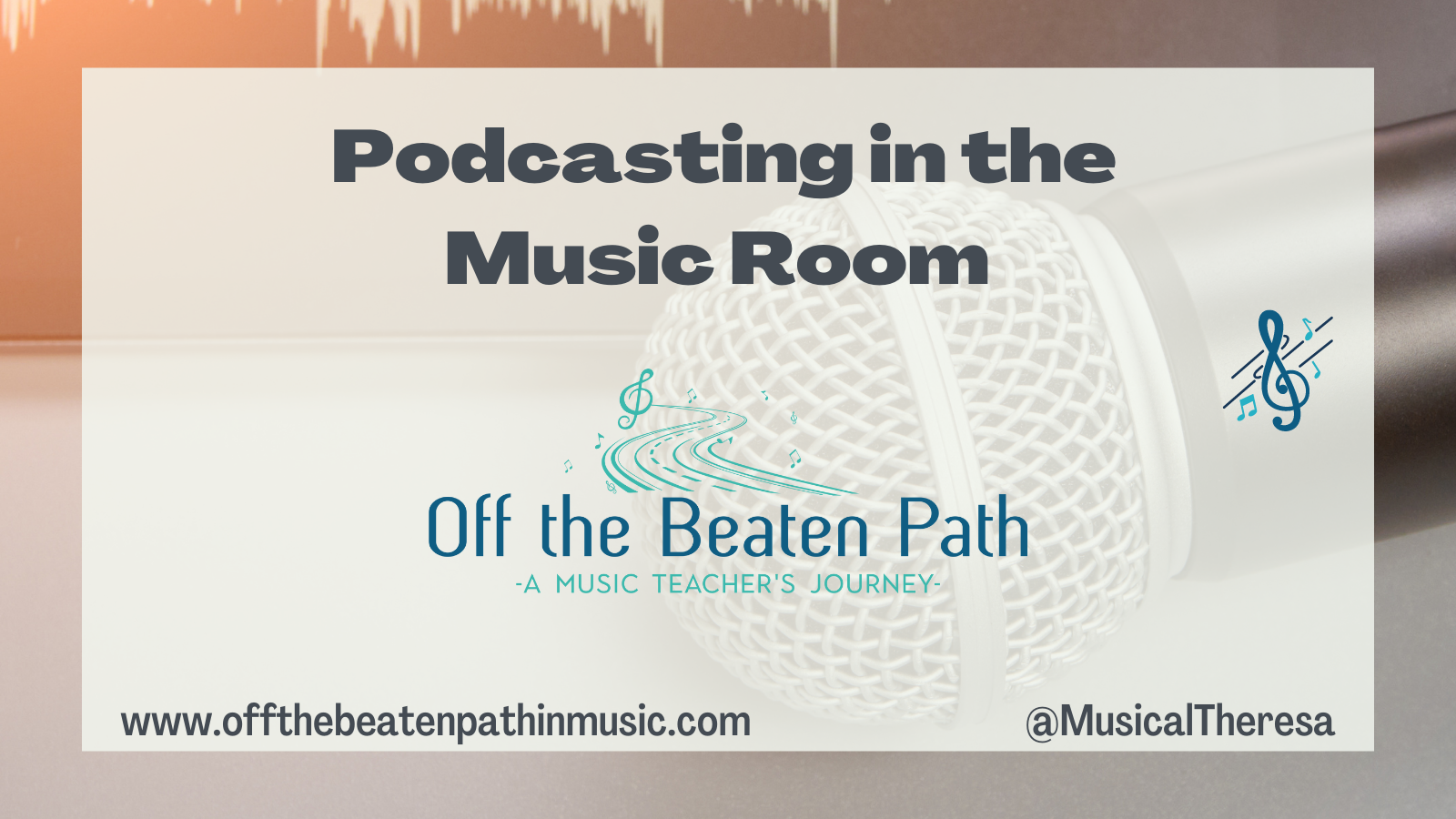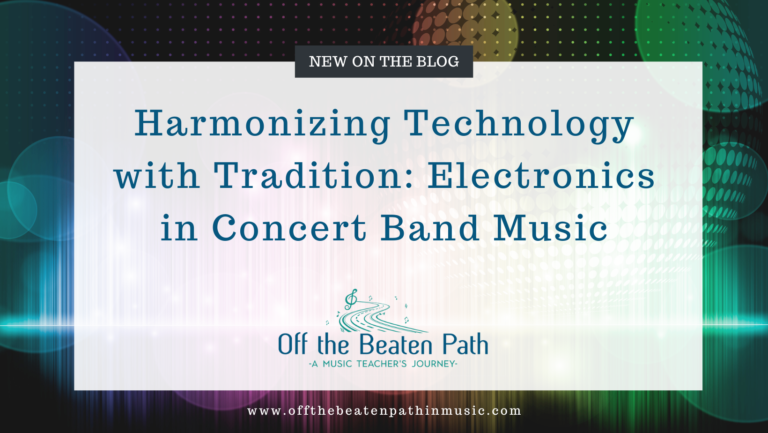Podcasting in the Music Room
I’ve always been one to try new things in the classroom. I like to experiment and I’m not afraid to take a risk. However, student musicianship is always at the center of each of these experiments. I want students creating music and learning about music in a way that’s meaningful to them. Last year, because of the COVID-19 pandemic, our ability to make music together was limited. When the students returned to the classroom in March, we were not allowed to play instruments. This was extremely concerning and made lesson planning challenging. I knew my middle school students loved band, but they loved band because they got to make music with their friends. And now this wasn’t an option. So I had to come up with something else that would engage, inspire, and empower my students as young musicians. That’s when I decided we would do a podcast project.

My idea for the project was that students would create podcasts about a music-related topic of their choice. Students would research their topic, then record the podcast in GarageBand, learning to use its basic audio editing features. They would create intro and outro music to accompany their podcast, along with any additional sound effects they felt would enhance the listeners’ experience. Students could also create cover art to go along with their podcast. I created a free account in Anchor to host the podcasts, so students should publish and share their work.
Before presenting this project to my students, I did some research and looked for resources available for student podcasts. There were several blog posts, articles, and other similar resources online that helped guide me. I also reached out to my PLN on Twitter to see if any current podcast hosts would talk to my students about their experiences. The response was incredible! I found one person to talk to each class, and several of the others recorded Flipgrid videos, sharing their favorite podcast tips. You can find the Flipgrid link, along with some other resources, at the bottom of this post.


The Process
Step 1: We begin with some rapid ideation. Using Jamboard, students got two minutes to list all the things they were interested in related to music, then two minutes to list everything they wanted to learn more about in music, and two minutes to list everything they thought they were experts in related to music. From there, students looked at all three lists and circled their favorite idea on each one. It was only at this point I told students they would create their own podcasts! They were told to imagine that each circled topic was a podcast, and to come up with three potential episodes for each topic. Students used these ideas to make their final selection and chose their podcast topics. After this ideation process, students had to submit their podcast topic, title, and three potential episode ideas.
Step 2: Now that students knew they were going to be hosting a podcast, they listened to some podcasts and made notes about things they noticed; guests, format, music, or anything that caught their attention. I encouraged students to think about which elements from these podcasts they might want to include on their own. In addition, students were to think about who their their ideal audience would be, and who they hoped would listen to their podcasts. Full class and small group discussions helped students clarify and expand upon their ideas.
Step 3: During the next class period, the “podcast experts” joined our class using Zoom. Each guest had a unique spin on how they would approach the topic. Some common themes included where ideas come from, the importance of having an outline but not necessarily a script, how to create interest for the audience, and some details about hosting the podcast. The session concluded with an opportunity for students to ask questions. Many asked about recording tips and how to come up with ideas. One entrepreneurial student even asked about how to get sponsors! He was disappointed when I said that wasn’t an option for our class podcast.
Step 4a: Once students had confirmed their podcast topics, they were ready to create an outline for episode one. Most students had research to do, though some could dive right into the writing. I provided an outline for interested students via Google Docs. You can find this outline in the resources at the end of this post.
Step 4b: Students also recorded an introduction episode. This episode was one minute introducing themself, their topic, and why they were excited to create a podcast about the topic. This episode was for students to practice using and recording themselves in GarageBand.
Step 5: Now they were ready to record! I encouraged students to use their outlines and to practice what they would say before recording. Students at home could report anywhere in their homes, students in the classroom could use the various practice rooms and storage rooms as a quiet recording space. It was great to see them concentrating, working hard, and excited about their final products.

Step 6: While there was some GarageBand instruction taking place throughout the last several steps, it was around this point that we talked about creating intro and outro music. Students could use any of the included loops in GarageBand, or create their own music for this purpose. I explained basic editing skills, and students were happy to hear they didn’t need to complete a perfect recording in one take.
“I provided students with tools, but not a formula, so the projects could reflect each student’s interests, personality, and experiences.”
The Results
Each student took a different approach, which was fine and really ideal. I provided students with tools, but not a formula, so the projects could reflect each student’s interests, personality, and experiences. Most students recorded solo episodes, where they talked about a specific topic on their own. Some students worked with a co-host and spoke together on the topic. A few students interviewed guests, mostly classmates, though some interviewed family members and friends who weren’t in band. Some podcasts were only a few minutes long, while others ran 20 to 30 minutes. Some students used transition music and other special effects. Others just spoke and let their words convey the message.
The topics students chose were varied and impressive! Several wanted to learn about and talk about music from movies and TV. Some students wanted to have their podcast be about famous composers, or time periods in music. One student created a podcast about the music from recent Super Bowl halftime shows. Another talked about the physics of music, specifically as it related to her instrument, the flute. Some talked about their own instruments, their history, how to play it, or tips and tricks for beginners. It was great to learn about their musical interests in this way!
Some students struggled to come up with a topic or struggled because they didn’t see value in the project. I knew this was a possibility from the beginning. Not every child would want to create a podcast. Not every child would want to record their spoken voice. This is something that in the future I would want to address better. What could an alternative be for students who weren’t comfortable creating podcasts?

When students were happy with their first episode, they submitted it through our LMS (Canvas) along with the title and a short episode description. I uploaded everything to Anchor, making the podcasts available to the public – it was a very simple process. Any student who did not want their podcast public had to tell me when submitting their assignment. I was happy to respect their wishes.
The Benefits
As a band teacher, I’m not sure if I would repeat this project in its entirety in non-pandemic years. It took a lot of time where students were not playing their instruments. However, the students were empowered throughout the project using their voices, making choices, and creating something for an authentic audience. They also thoroughly enjoyed listening to the podcasts recorded by their classmates! I witnessed many great conversations between students as they commented on similarities or things they learned.
Creating the podcasts provided students with several valuable opportunities, including:
- Time to dive deep into a musical topic of their choosing
- Learning how to edit in a digital audio workstation (DAW)
- Learning how to create short musical compositions using loops in a DAW
- Creating a product, publishing it, and sharing it with the world
While none of these things involve playing instruments, there was still a lot of value in what students gained from this project. I would highly recommend it for general music classes, music appreciation classes, music history classes, or other similar situations. Any time students can take ownership of a project and any time students incorporate their own interests, the experience will be more meaningful and long-lasting.
Interested in trying a podcast project in your own classroom? Or just want to learn more? Enter your email below to get a document containing everything you need to get started! Web resources, templates, advice from the experts, and more!




